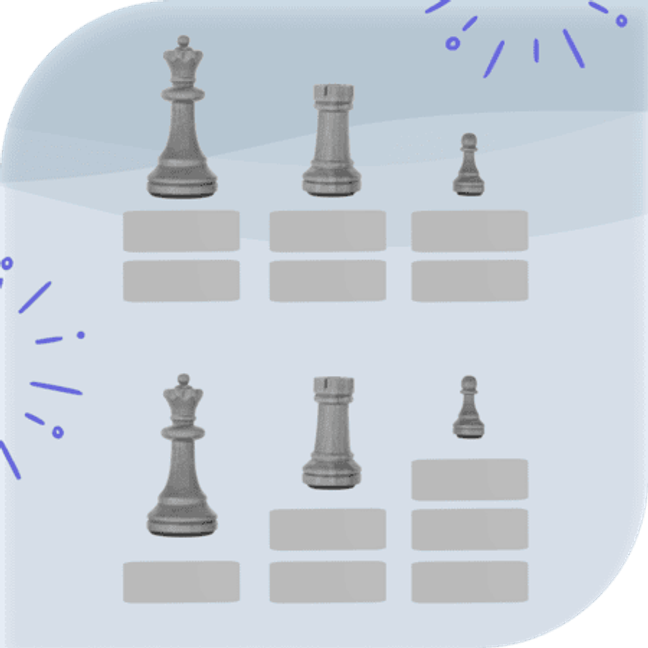Equity vs. Equality

The terms equity and equality sound similar, but the implementation of one or both of them can lead to dramatically different impacts for people who are marginalized. It is important to understand that the terms equity and equality are not synonyms and cannot be used interchangeably.
Equality means that every person or group of people is given the exact same opportunities and resources, regardless of where they start. The term equality also implies that everyone is equal in rights, status, and opportunities. Regardless of circumstances, people are given the same resources, support, and opportunities.
Equity recognizes that people have different set of circumstances, and people don’t all have the same starting point. With equity, resources and opportunities are allocated so that everyone has the chance to reach the same outcome. With equity, individuals have an impartial and fair pathway to results because the current and historic inequalities in people’s lives are removed.
When equity is employed, people may start with a different set of resources, but everyone has the same chance for an outcome that helps them improve and grow.
Example:
A classic representation of the difference between equity and equality is a set of images comparing two children looking over a fence at a baseball game.
- Equality: In the first image, there is one tall child and one short child. They have identically sized ladders, and the result is that the tall child can see over the fence while the short child can’t. This image depicts equality because both children, regardless of their circumstances (tall vs. short), have the same-sized ladder. The two children don’t have the same starting point, and the short child has a disadvantage.
- Equity: In the second image, the same two children are pictured. However, in this image, the tall child has a short ladder, and the short child has a taller ladder. The result is that both children have the exact same view of the baseball game. This image depicts equity because there was a recognition that the two children didn’t start with the same advantages. The playing field was leveled when the shorter child was given a taller ladder.
A real-world application of equity would be students in a classroom not having all the tools they need to succeed. Some children are performing more poorly than other children even though they have the same textbooks and classroom supplies.
When data is examined, officials discover that the children performing well have computers and internet access at home. A community group raises funds to provide laptops and wi-fi hotspots to students who are at a disadvantage so that every student has the same opportunity for success.
Related Terms
Diversity, Equity, and Inclusion (DEI)
are frequently grouped together because the three concepts are interconnected. When used in combination, a complete impact emerges. The three words describe values that organizations strive to embody so that theory can meet the needs of employees from all walks of life.
DEI Policy
is the term used to refer to an organization’s policies or programs used to promote Diversity, Equity, and Inclusion values. Having a DEI policy in place encourages recruiters to recruit and hire diverse team members and build a welcoming workplace that is free of discrimination.
Diversity, Equity, Inclusion, and Belonging (DEIB)
is an extension of the concept of Diversity, Equity, and Inclusion (DEI). While DEI focuses on creating a diverse and inclusive workplace, DEIB takes it a step further by also focusing on creating a sense of belonging for all employees. This means fostering an environment where individuals of all backgrounds feel valued, respected, supported, and included in the organization's culture and community. DEIB initiatives can include but are not limited to employee resource groups, employee engagement surveys, affinity groups, cultural competency training, and other employee development opportunities that focus on creating an inclusive and equitable workplace culture and promoting a sense of belonging for all employees.
Justice, Equity, Diversity, and Inclusion (JEDI)
is a framework that organizations and individuals can use to create a more equitable, inclusive, and just society. JEDI is an intersectional approach that recognizes that issues of justice, equity, diversity, and inclusion are interconnected and cannot be addressed in isolation.
Justice refers to the fair and equitable treatment of all individuals, and the creation of a society that is free from discrimination and oppression. This includes addressing systemic issues such as poverty, racism, and other forms of injustice.
Equity refers to the fair distribution of resources and opportunities, taking into account the different needs and circumstances of individuals and communities. This means recognizing and addressing the ways in which historic and current systems of oppression have led to disparities and working to ensure that everyone has what they need to succeed.
Diversity refers to the recognition and valuing of differences among individuals and groups. This includes differences in race, ethnicity, gender, sexual orientation, ability, age, and other characteristics.
Inclusion refers to the active engagement and involvement of individuals and groups who have been historically excluded or marginalized. This includes creating an environment where everyone feels welcome, respected, and able to fully participate.
Together, these elements work to create a more just, equitable, diverse, and inclusive society, where everyone has the opportunity to thrive.